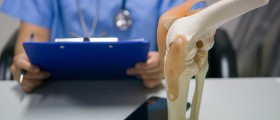
Degenerative joint disease is a serious medical condition that eventually leads to disability of different extent. There are many structural changes responsible for such outcome including wear and tear of joint cartilage, overgrowth of bone (formation of osteophytes), narrowing of the joint space and deformity of the entire joint. The previously mentioned characteristics occur in patients suffering from osteoarthritis. This type of arthritis can actually be end stage of other forms of arthritis such as rheumatoid arthritis, post-traumatic arthritis etc.
Clinical Characteristics of End Stage Degenerative Joint Disease
In the beginning patients start to complain about joint stiffness which lasts longer than 15 minutes. After this period of time the joint becomes mobile again. But once the stiffness is gone one may start to feel pain of different intensity which usually accompanies motion of the affected joint. Any kind of movement, especially weight-bearing activities is responsible for the occurrence of pain. Symptoms and signs of the condition tend to become worse during the day and may significantly improve at night.
In spite of remnant mobility of the affected joint, progression of the disease and entering end stage typically features with limited motion of the affected joint. Coarse crepitus (a cracking sound) is another characteristic of severe damage to the joint which usually occurs during the initial movement of the joint in the morning. Additional problems include swelling of the tissues around the joint and tenderness of the entire area. The affected joint is due to the process of inflammation warm.
Treatment for Degenerative Joint Disease
Treatment for degenerative joint disease depends on many factors including patient's age, overall health, type of the disease he/she is suffering from and degenerative changes that have already affected the particular joint.
Mild and moderate forms of the disease can be treated only with properly created and supervised exercise program. Such patients may benefit from different activities such as swimming and cycling. Physical activity is essential for maintaining strength of the nearby muscles, tendons and ligaments and is also ideal for maintaining optimal body weight and prevention of obesity.
Patients in end stage degenerative joint disease experience severe pain which can be only alleviated with certain drugs. The most commonly prescribed medications include acetaminophen and other NSAIDs (ibuprofen, naproxen etc.). But in case these drugs do not provide with optimal pain relief they are replaced with other pain killers that are more potent. The drugs are administered orally or in a form of injections. Patients suffering from severe osteoarthritis may also feel relief due to glucosamine-chondroitin sulfate. This drug successfully reduces pain and restores nutrition to damaged cartilage at the same time.
In advanced stages patients may depend on braces, splints and other orthotic devices. And finally, the last treatment option is surgery. One of frequently performed surgeries in patients with end stage degenerative joint disease is total hip replacement and partial/total knee replacement surgery.


-Symptoms,-Diagnosis,-Treatment_f_280x120.jpg)














Your thoughts on this
Loading...